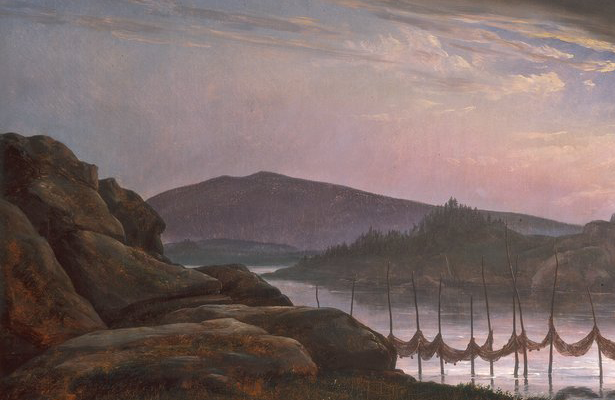In 1811 Johan Christian Dahl moved from his native Bergen to Copenhagen, where the twenty-three-year-old landscape painter studied in the Academy of Fine Arts. Dahl combined an interest in Dutch seventeenth-century landscape painters such as Jacob van Ruisdael and Allart van Everdingen with the influence of the crisply observed Roman landscape views of his contemporary Christoffer Wilhelm Eckersberg, whose work he discovered in Copenhagen. Dahl remained a specialist in landscapes, painting open-air oil studies, finished views, and imaginary landscapes based on memory and on the work of his Dutch predecessors. In 1818 Dahl traveled south, spending two years in Dresden, where he fell under the strong influence of the German romantic landscape painter Caspar David Friedrich. At the invitation of the Danish prince Christian Frederick, Dahl traveled to Rome and Naples, where he painted oil sketches and finished views of Italian sites. In 1821 he returned to Dresden, remaining for the rest of his life and sharing a house with Friedrich. Dahl made frequent trips to Norway and Denmark, and exhibited regularly in Copenhagen.
View from Vaekerø near Christiania was painted in Dresden in January 1827, after one of Dahl’s trips to Norway (he had visited Christiania, present-day Oslo, the previous summer). An annotated landscape drawing dated June 1826 survives (National Gallery, Oslo), showing the ship and nets hanging out to dry at Vaekerø. The painting is infused with a melancholy, nocturnal mood frequently found in the art of Friedrich, and the repertoire of romantic motifs–cloud-covered moon, rocky inlet, misty hills, haunting ship riding at anchor, drying nets, and the couple contemplating the nocturnal scene–can also be found in the great German painter’s works. Indeed Dahl owned one of Friedrich’s most characteristic and comparable landscapes, Two Men Contemplating the Moon, which he sold to the Royal Picture Gallery in Dresden in 1840. View from Vaekerø near Christiania is one of Dahl’s most Friedrich-like landscapes, and as such is a highly typical example of romantic landscape painting of the Dresden school. For all that it was painted from memory, it has a remarkably fresh feeling for nature, especially in the subtle effects of light modulated by clouds, mist, and reflections. It was commissioned from Dahl by the Hamburger Kunstverein, an artists’ cooperative and exhibiting society in Hamburg, Germany, where it was exhibited in 1827 and purchased by a Norwegian collector, Jacob All.













